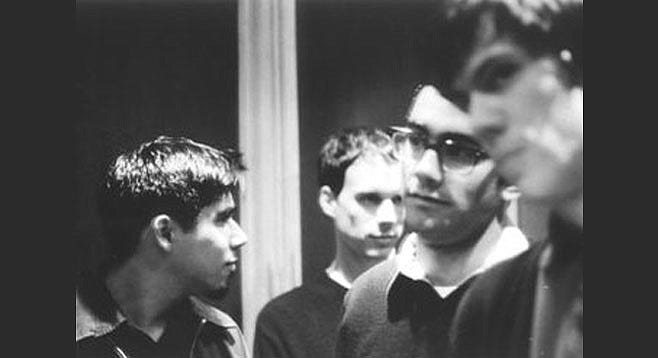Kill Holiday | History of the Band
A Hardcore Detour: When Unbroken’s Members Got Melodic
You might think of hardcore as rigid, all fury and no room for melody. But in 1994, Steven Andrew Miller—guitarist for San Diego’s straight-edge powerhouse Unbroken—was already itching for something more expansive. He teamed up with Robert Moran (also Unbroken), Barry Kellman (Amenity/House of Suffering), and Oscar Paz (Statement, Impel), forming Kill Holiday as a creative detour.
The name was ironic, almost like a dare to fans expecting breakdowns and shouted refrains. Instead, the band’s 1995 debut EP Monitor Dependency on New Age Records layered emotion over aggression, catching the ears of post-hardcore fans craving melody with their weight.
Jason W. suggested this artist for a future Dig Me Out podcast episode. Each month, our Patrons are presented with a selection of albums suggested by listeners and asked to vote for their favorite.
Musical Style and Evolution
At first, Kill Holiday felt like an extension of the mid-90s melodic hardcore movement: heavy, introspective, with just enough tunefulness to stand apart. But what if you took that emotional weight and replaced the aggression with jangly guitar lines and melancholic vocals?
That’s exactly where the band headed. By the time 1997 rolled around, they had absorbed a different kind of influence—The Smiths, Ride, The Charlatans UK. The transformation was startling. The guitars shimmered. The pace relaxed. They weren’t shedding their past as much as refracting it through a Britpop lens.
Discography and Notable 90s Releases
Monitor Dependency EP (1995)
Released on New Age Records, Monitor Dependency still wore its hardcore influences proudly. But underneath the thick riffs were hints of the shift to come. Steven Andrew Miller’s vocal phrasing started leaning into mood and melody.
Meant to Let You Down 7" (1997)
By now, the transformation was undeniable. Released via Simba Records, this single traded punch for pensive. The guitar interplay—handled by Christopher Perreira and Miller—echoed UK guitar pop, while the rhythm section (Todd Beattie on bass, Gabriel Gamboa on drums) kept it grounded.
Somewhere Between the Wrong Is Right (1999)
Here’s where it all came together. Released on Revelation Records, the full-length debut was more Blur than Black Flag. Guitars chimed. Keyboards floated. Lyrics brooded.
Recorded with a careful attention to tone and texture, this album was equal parts homage and evolution. Listeners familiar with the band’s hardcore past were stunned. Was this still the same band? It was—and that dissonance made the album feel even more alive.
The reaction? Mixed, at first. Some longtime fans were bewildered. Others were hooked. One reviewer on Revelation Records’ own site confessed: "When I first heard this I couldn't tell if I hated it and thought it was too cheesy or if the pop-loving side of me was in love with it".
That kind of honesty says it all. Kill Holiday didn’t ease you into their new sound. They jumped headlong into it, and trusted listeners to follow—or not.
Influence and Legacy
Looking back, Kill Holiday wasn’t just shifting styles. They were mapping new terrain. Their evolution mirrored a broader question plaguing many 90s bands: Can we be more than our genre?
The answer, for them, was yes. In hindsight, their willingness to leave behind a successful formula gave them lasting intrigue. You can hear their influence in bands that later blurred hardcore and shoegaze, or indie pop and emo.
And the members didn’t disappear. Oscar Paz and June Cate later formed Hingada, keeping that spirit of post-hardcore-meets-melody alive.
Kill Holiday’s 90s run was brief—but never boring. They were a band willing to walk away from expectations and try something risky. They didn’t dominate the scene, but they carved out a strange and beautiful corner in it.
If you missed them the first time, now’s your chance. Because in a decade defined by reinvention, Kill Holiday fit right in—by standing out.
Time to Vote: Which 90s Album Should We Dig Into Next?
Last month, you picked Thelonious Monster – Beautiful Mess—and we had a blast digging into it on the latest episode of the 90s Rock podcast. A folk-punk underdog with major-label drama, L.A. scene cred, and guest spots from Soul Asylum, Tom Waits, and more—it sparked a deep dive into one of the era’s most chaotic and compelling stories.




